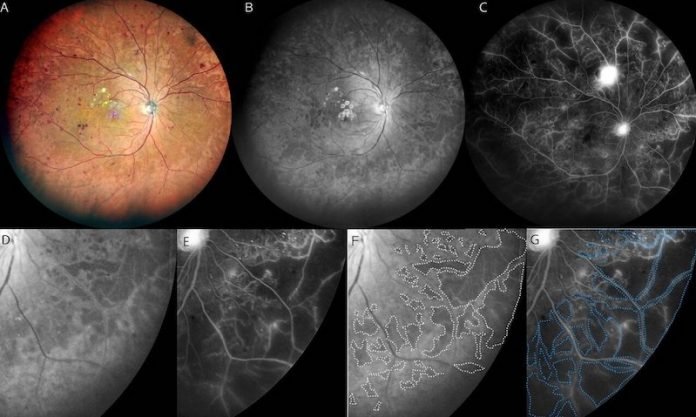
In a new study from Tokyo Medical and Dental University, researchers found a thorough and non-invasive imaging technique to identify areas of the eye affected by diabetic retinopathy, a progressive eye disease associated with diabetes.
Just as bright light can illuminate the depths of a darkened room, the researchers found that blue light can be used to probe the depths of the eye and uncover areas affected by diabetic retinopathy, a leading cause of blindness.
They found that blue images obtained by multicolor widefield scanning laser ophthalmoscopy (SLO) may be used to identify areas of DR-induced damage in a more extensive portion of the eye compared with previous methods.
Current eye imaging methods include fluorescein angiogram, which involves the injection of dye into the eye.
SLO is a non-invasive approach that does not require dye, and multicolor widefield SLO represents an advancement of this technique in which red, blue, and green lasers are used to simultaneously capture images of a wide portion of the eye.
In the study, the researchers compared blue widefield SLO images and fluorescein angiogram images taken in people with diabetes.
They found that the hyporeflective areas in the blue widefield SLO images appeared to correspond with areas of ischemia in the fluorescein angiogram images of patients with diabetic retinopathy.
Further evaluation of patient images showed that ischemic areas (i.e., areas of reduced blood flow) appeared to correspond with parts of the retina that were thin and partially disorganized.
The team says it’s possible that the blue wavelength of light can pass more easily through these thinned areas of the retina, which presents as hyporeflective areas in the SLO images.
This study confirms the utility of blue widefield SLO as a simple and non-invasive tool for the detection of diabetic retinopathy-associated damage in the eye.
This technique may serve as an important means of screening and monitoring disease progression in individuals with the disease.
If you care about diabetes, please read studies about this diabetes drug could reduce body fat in people with obesity and findings of newer diabetes drug can protect kidney and heart health.
For more information about diabetes and your health, please see recent studies about this daily habit could effectively prevent type 2 diabetes and results showing that this weight loss drug could strongly benefit people with type 2 diabetes.
The study is published in Asia-Pacific Journal of Ophthalmology. One author of the study is Kyoko Ohno-Matsui.
Copyright © 2021 Knowridge Science Report. All rights reserved.


